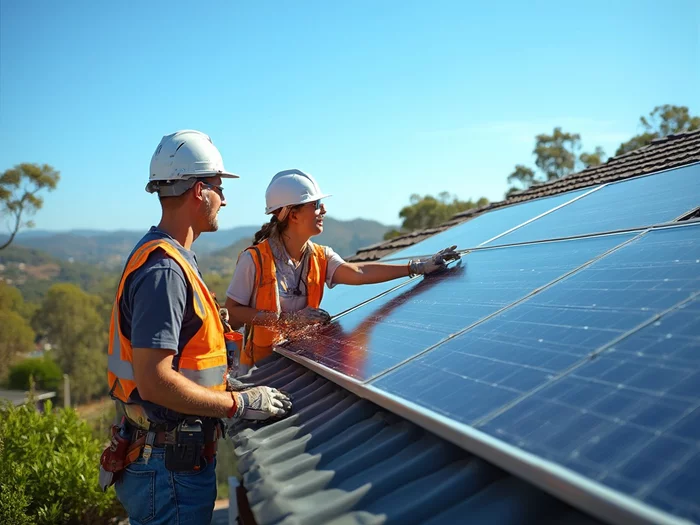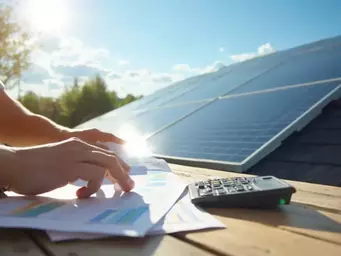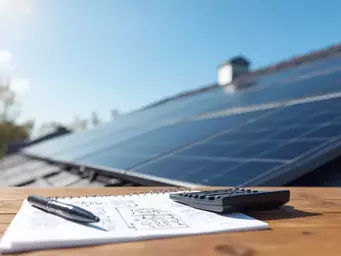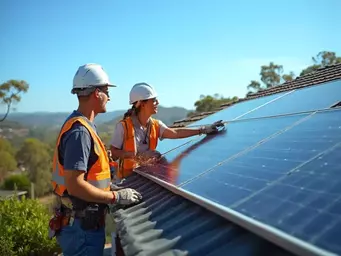Phase OneSite Assessment
Evaluation of property, roof orientation, shading, and structural integrity to determine optimal panel placement and energy production.
Unlock expert insights on solar panel installation, energy savings, and government rebates for Australian homes and businesses. Join our community of informed solar enthusiasts!
Posted on: 2025-10-13
By: Evelyn Tran
Choosing the right solar installer can significantly impact your renewable energy journey. Are you ready to make an informed decision that ensures efficiency and longevity for your solar system?
The solar journey involves several critical phases, from initial assessment to final inspection. Understanding each step ensures a smooth and successful transition to renewable energy.
Evaluation of property, roof orientation, shading, and structural integrity to determine optimal panel placement and energy production.
Creating a tailored solar system plan, handling necessary permits to comply with local regulations and safety standards.
Physical installation of panels and components, followed by a thorough inspection to ensure functionality and compliance.
Familiarization with local laws and requirements, crucial for avoiding potential roadblocks and ensuring project success.
Choosing the right solar installer is a crucial step in your journey toward harnessing renewable energy. At Longi Solar Solutions, we emphasize the importance of selecting an accredited solar installer to ensure you receive quality service and installation. An accredited installer not only adheres to industry standards but also provides peace of mind knowing that your investment is in capable hands.
By working with accredited professionals, you can avoid common pitfalls and ensure that your solar system is installed correctly, maximizing its efficiency and lifespan. In a market that can sometimes feel overwhelming, accreditation serves as a reliable indicator of expertise and trustworthiness.
Accreditation is essential for several reasons. First, it guarantees that the installer has undergone rigorous training and is knowledgeable about the latest solar technologies and installation techniques. This expertise is critical in ensuring that your solar system operates at optimal performance. Additionally, the Clean Energy Regulator provides information on rooftop solar installers and designers, highlighting the importance of choosing qualified professionals.
Ultimately, when you choose an accredited solar installer, you're investing in a smoother installation process and a reliable energy solution for the long term.
In Australia, two prominent organizations set the standard for solar installer accreditation: the Clean Energy Council (CEC) and Solar Accreditation Australia. These bodies ensure that installers not only meet technical requirements but also adhere to ethical business practices.
Both accreditations serve as a testament to an installer's commitment to excellence. Choosing a solar installer with one or both of these accreditations can significantly influence the success of your solar installation and your overall satisfaction.
When selecting a solar installer, always request references and check their past projects. Speaking with previous clients can provide valuable insights into the installer’s reliability and the quality of their work, ensuring that you make a well-informed decision.
Understanding the solar installation process is crucial for anyone looking to harness renewable energy. At Longi Solar Solutions, we aim to empower homeowners and businesses with knowledge about what each phase entails. This way, you can feel confident and informed every step of the way!
From the initial site assessment to the final inspection, knowing what to expect can greatly reduce any uncertainty. Let’s break down the solar installation process into manageable phases:
Each of these steps plays a vital role in ensuring your solar system is installed efficiently and adheres to local regulations. Let’s take a closer look at what each phase involves.
The first step in the solar installation process is the site assessment. During this phase, an installer will evaluate your property to determine the optimal placement of solar panels. Factors such as roof orientation, shading, and structural integrity are considered to maximize energy production.
It’s essential to have a thorough site assessment to ensure that the solar system meets your energy needs. This initial visit will provide valuable insights into the feasibility of your solar project.
Once the site assessment is complete, the next step is system design. This involves creating a tailored solar system plan that matches your energy requirements. Your installer will then handle the necessary permitting procedures to comply with local regulations.
This phase is crucial because it ensures that your solar installation adheres to safety standards and local codes, paving the way for a smooth installation process.
The actual installation involves installing the solar panels, inverter, and other components on your property. After installation, a final inspection is conducted to ensure everything is functioning correctly and meets all guidelines. This is a great time to ask your installer any questions you might have about your new system!
It’s important to remember that a well-executed installation can enhance the performance and longevity of your solar system.
Lastly, being aware of local regulations is essential for a successful solar installation. These laws can vary significantly from one area to another, affecting everything from the type of equipment you can use to how permits are obtained.
By understanding these regulations upfront, you’ll avoid potential roadblocks and delays in your solar project. Don’t hesitate to ask your installer about any local requirements that may apply to your situation!
Here are some common questions to help you make an informed decision about your solar installation:
Here is a quick recap of the important points discussed in the article:

 Ready to unlock the potential of solar energy for your home? Understanding the financial landscape o
Ready to unlock the potential of solar energy for your home? Understanding the financial landscape o
 As you contemplate the shift to solar energy, consider this: a comprehensive understanding of the co
As you contemplate the shift to solar energy, consider this: a comprehensive understanding of the co
 Choosing the right solar installer can significantly impact your renewable energy journey. Are you r
Choosing the right solar installer can significantly impact your renewable energy journey. Are you r